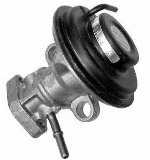 EGR (exhaust gas recirculation) valves serve a specific purpose in engines. They recirculate exhaust gases from the exhaust stream, sending some back into the engine to be burned again. This helps to reduce emissions by further burning the byproducts of combustion.
EGR (exhaust gas recirculation) valves serve a specific purpose in engines. They recirculate exhaust gases from the exhaust stream, sending some back into the engine to be burned again. This helps to reduce emissions by further burning the byproducts of combustion.
EGR valves can be thermally operated or electrically operated. Generally, there is an operating mechanism that “opens” and an actuator mechanism that makes it do so. Older style EGR’s had more mechanical operation driven by heat to open the valve. More recent styles feature electrically operated valves.
What Material Should You Use?
If you are involved with making the decision on EGR gasket material, there are 3 main items of consideration.
1. Temperature Involved
EGR by nature is a hot application. Designers need to know the temperature exposure that an EGR seal point would see to determine what material to use. Generally, a metal-reinforced material is the proper solution. With high temps (>1000°F), a mechanically clinched product is best. Over the years, flexible graphite has been an excellent solution in this area. High-temp fiber products have also shown good performance and offer insulative properties as well.
2. Flange Load
Generally, an EGR valve flange features stiff flanges and 2 sufficient bolts. This is usually adequate for a tanged metal composite gasket (either graphite or high-temp facing) to seal both initially and long term. For joints where less flange load is available and temperatures are not as high, a solid core graphite design might be considered.
3. Insulate or Conduct
The thermal question is key. With the exposure to high temperature always present, the control part of the valve needs to be protected or isolated from the heat. In many cases, designers prefer an insulative material to accomplish that task.
 Decide on a Material
Decide on a Material
EGR valve gasket applications are an excellent candidate for metal-reinforced, high-temperature gasket material.
If you have any questions about your EGR application, please let us know! If you are interested in subscribing to Sealed-In’s blog posts, email sales@mtigasket.com.
Metal Tech manufactures HT 400 and has had much success with it over the years in EGR valve gasket applications. The HT 400 offers thermally insulative properties to reduce heat flow and protect the components while maintaining an effective seal.

EGR (exhaust gas recirculation) valves serve a specific purpose in engines. They recirculate exhaust gases from the exhaust stream, sending some back into the engine to be burned again. This helps to reduce emissions by further burning the byproducts of combustion.
EGR valves can be thermally operated or electrically operated. Generally, there is an operating mechanism that “opens” and an actuator mechanism that makes it do so. Older style EGR’s had more mechanical operation driven by heat to open the valve. More recent styles feature electrically operated valves.
What Material Should You Use?
If you are involved with making the decision on EGR gasket material, there are 3 main items of consideration.
1. Temperature Involved
EGR by nature is a hot application. Designers need to know the temperature exposure that an EGR seal point would see to determine what material to use. Generally, a metal-reinforced material is the proper solution. With high temps (>1000°F), a mechanically clinched product is best. Over the years, flexible graphite has been an excellent solution in this area. High-temp fiber products have also shown good performance and offer insulative properties as well.
2. Flange Load
Generally, an EGR valve flange features stiff flanges and 2 sufficient bolts. This is usually adequate for a tanged metal composite gasket (either graphite or high-temp facing) to seal both initially and long term. For joints where less flange load is available and temperatures are not as high, a solid core graphite design might be considered.
3. Insulate or Conduct
The thermal question is key. With the exposure to high temperature always present, the control part of the valve needs to be protected or isolated from the heat. In many cases, designers prefer an insulative material to accomplish that task.
Decide on a Material
EGR valve gasket applications are an excellent candidate for metal-reinforced, high-temperature gasket material.
If you have any questions about your EGR application, please let us know! If you are interested in subscribing to Sealed-In’s blog posts, email sales@mtigasket.com.
Metal Tech manufactures HT 400 and has had much success with it over the years in EGR valve gasket applications. The HT 400 offers thermally insulative properties to reduce heat flow and protect the components while maintaining an effective seal.

EGR (exhaust gas recirculation) valves serve a specific purpose in engines. They recirculate exhaust gases from the exhaust stream, sending some back into the engine to be burned again. This helps to reduce emissions by further burning the byproducts of combustion.
EGR valves can be thermally operated or electrically operated. Generally, there is an operating mechanism that “opens” and an actuator mechanism that makes it do so. Older style EGR’s had more mechanical operation driven by heat to open the valve. More recent styles feature electrically operated valves.
What Material Should You Use?
If you are involved with making the decision on EGR gasket material, there are 3 main items of consideration.
1. Temperature Involved
EGR by nature is a hot application. Designers need to know the temperature exposure that an EGR seal point would see to determine what material to use. Generally, a metal-reinforced material is the proper solution. With high temps (>1000°F), a mechanically clinched product is best. Over the years, flexible graphite has been an excellent solution in this area. High-temp fiber products have also shown good performance and offer insulative properties as well.
2. Flange Load
Generally, an EGR valve flange features stiff flanges and 2 sufficient bolts. This is usually adequate for a tanged metal composite gasket (either graphite or high-temp facing) to seal both initially and long term. For joints where less flange load is available and temperatures are not as high, a solid core graphite design might be considered.
3. Insulate or Conduct
The thermal question is key. With the exposure to high temperature always present, the control part of the valve needs to be protected or isolated from the heat. In many cases, designers prefer an insulative material to accomplish that task.
Decide on a Material
EGR valve gasket applications are an excellent candidate for metal-reinforced, high-temperature gasket material.
If you have any questions about your EGR application, please let us know! If you are interested in subscribing to Sealed-In’s blog posts, email sales@mtigasket.com.
Metal Tech manufactures HT 400 and has had much success with it over the years in EGR valve gasket applications. The HT 400 offers thermally insulative properties to reduce heat flow and protect the components while maintaining an effective seal.
